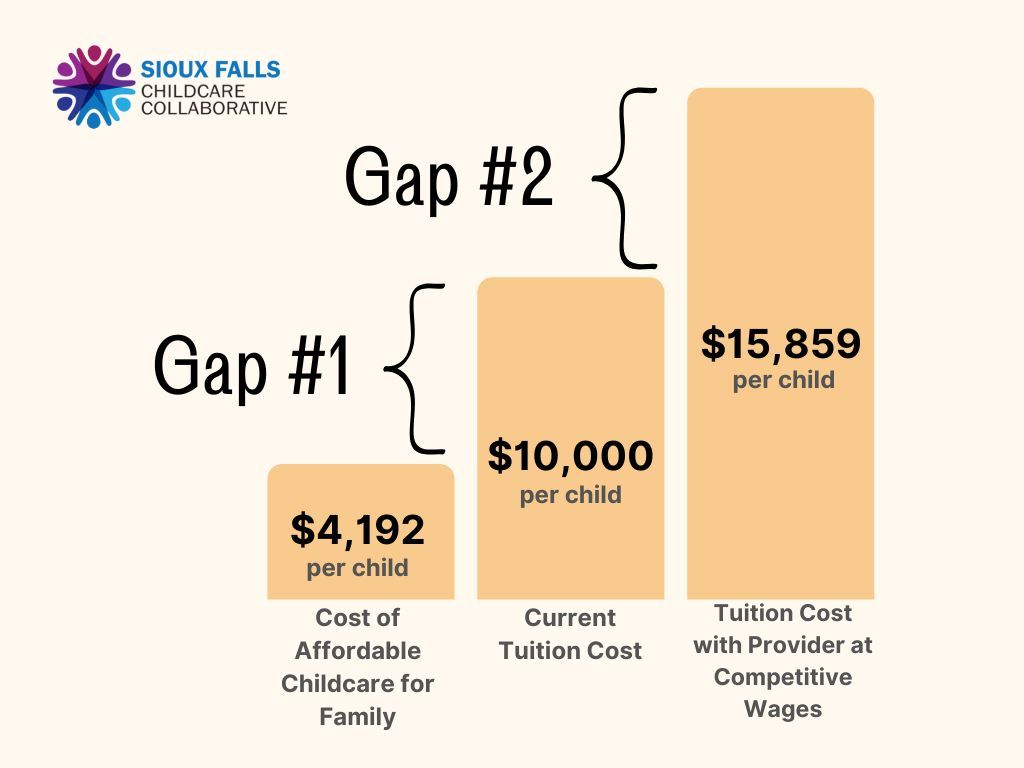Simplified: Even if Sioux Falls businesses start helping cover the costs of childcare for employees, it likely won't be enough to bridge the gap between what parents can afford and what it takes to pay childcare providers a competitive wage, according to analysis from the Sioux Falls Childcare Collaborative
Why it matters
- The childcare industry faces two significant gaps in South Dakota. First, there's the gap between what parents can afford to pay – defined by the federal government as no more than 7 percent of the median income, or about $4,200 per kid per year in South Dakota.
- Then, there's the gap between what parents are paying now – about $10,000 per kid per year, and what it would take to pay childcare providers a competitive wage, i.e. an increase from an average of $10.39/hour to $18/hour.
- The Childcare Collaborative's analysis comes as part of a six-month dedicated effort to find solutions to the childcare crisis facing parents. Rana DeBoer and Nicole Fluth were hired in early October with a goal of working full-time on this issue.
- By November, DeBoer and Fluth realized that businesses would need to be part of the equation. That's still true, but they told Sioux Falls Simplified that in every other successful example of childcare solutions in other states and cities, there's also a level of broader community or local government support.
"Businesses can step in and help, but to cover both of those gaps it kind of has to come from multiple angles," Fluth said.
Remind me again, what's the scope of this crisis?
It's a big one.
Statewide, the collaborative estimates that it's a $636 million gap between what parents can afford to pay and what providers need to hit that $18/hour average wage.
Oof. Ok, and how can we bridge that gap?
That's exactly what DeBoer and Fluth are figuring out.
It's clear that businesses need to be part of the solution. The two women described the childcare industry as the "workforce behind the workforce," because without adequate childcare, parents aren't able to work.
But, it's also becoming increasingly clear that there has to be a third source of funding in addition to parents paying tuition and businesses chipping in. In many cases, that funding source is the state, Fluth said.
- In Michigan, for example, there's what's called a "tri-share" model of childcare. Parents pay one-third of the cost. Employers pay another third, and the state of Michigan pays the final third.
What if the state doesn't help?
The state of South Dakota is one of only a handful in the country with no dedicated budget for childcare.
- It's unlikely that will change, at least in the near future, Fluth and DeBoer acknowledge. But the Childcare Collaborative is looking for creative ways to find funding at a more local level for Sioux Falls-area parents.
There are some promising local examples. In West Fargo, the city just approved a grant program to help fund day care operations.
- Fluth and DeBoer will be asking businesses and community organizations what they think is possible in Sioux Falls.
What happens next?
The next big step is bringing more businesses on board with helping pay for childcare.
The collaborative is hosting an event at 8:30 a.m. Wednesday, March 8 at Southeast Technical College where businesses can learn more about how they can help. Register for that event here.
Beyond that, the Childcare Collaborative is putting together its findings, and in the coming months will be sharing even more information about how Sioux Falls can help address the community's childcare needs.


